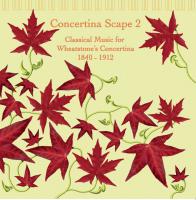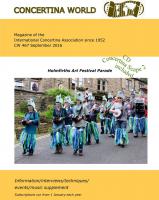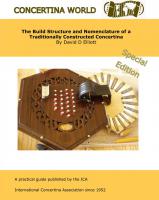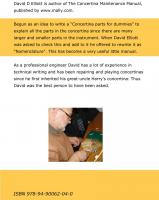-
Posts
138 -
Joined
-
Last visited
Posts posted by pauline de snoo
-
-
Soon the new deadline appraoches. If you want your event published, or a write up of it, reviews of your cd and or books do mail the editor at editorCW@concertina.org
have a look at www.concertina.org for indexes of previous issues.
-
It was suggested (by me )that members could enter a yearly competition by sending in recordings and the winner (s) getting a diploma, but sadly it never took off. I still think it was a good idea.Competitons can improve the general standard of playing and give players yearly targets to aim for.
Al
Lots of talk and thoughts on the subject but alas sofar quite difficult to realise. There are however the basics for gradings which I made for the Victoria College of Music. But that has proven difficult to access for a few members who were interested. They have however published the first books for the lower level of grading exams. Will write about it in the magazine later this year.
-
Indeed as John says, things have changed tremendously. The International Concertina Association is no longer a London based group of concertina players with regular meetings.
The ICA has become an organisation with members all over the world (20 - 25%) and the rest widespread over the UK. It's editor even based outside the UK as well as the webmaster. So very international that since many years the Internet and the magazine are the most important reason for people to be a member of the ICA. There are no longer local meetings. We still organise an AGM but that has been under discussion to change to a postal vote or email vote. The last AGM only held recently on 22 April with about 27 members present. That is only a tiny part of the membership and is s good number but committee members have been considering changes to the constitution because of the changed status of the ICA.
In the mean time it is certainly my personal aim to provide for all these members so far and wide a magazine with interesting information which they might not read otherwise. After all reading longer articles and interviews or technical issues on a computer or tablet is not always really pleasant and a magazine can also be saved for many years so that it is easy to go back to much later in time. I still prefer a real book to an E-book.
The International Concertina Association would like to be an umbrella type of organisation where all concertina groups in whatever size or location, wherever in the world can be assisted in some way by the ICA and In whatever form the ICA thinks appropriate,.
-
Indeed the International Concertina Association is quite active but not so much on this website. There is the magazine which is sent out 4 times a year and regular as clockwork with lots of interesting interviews and sometimes extra supplements. Have a look a the website www.concertina.org for indexes of previous magazines. Then there is the facebook page of the International Concertina Association and the Youtube channel. All can be accessed by using the links on the website. As well as twitter and soundcloud.
However the most informative outside the website are the magazine and the facebook page.
The magazine has contents that is not published or limited on the internet. At least later so that members who have a subscription have the advantage of reading items first. In my view gradually over time the magazine has changed from Newsletter to Magazine.
Last issues have contained a story by Douglas Rogers and an interview with Vic Gammon. Items that you read nowhere else.
I have been so busy with the magazine and the other publication channels we use that I have not spent much time here. However have a look at the website and discover more. I will try to publish some more info here in the future. And Alan Day you are more then welcome to send in one of your stories as you have done in the past. Look forward to that.
If anyone of you wants your events published do mail me at editorCW@concertina.org
The magazine is published in RILM (Répertoire International de Littérature Musicale
The Graduate Center of The City University of New York,) which makes it accessible to Universities and Libraries and others that are interested all over the world.
-
Thank you Geoff for this information. Interesting for CW!
-
The first three pieces mentioned by Jake: Andante and Scherzo, Gavotte in G and Recollections of England are mentioned in Wheatstone's Catalogue of music for the English Concertina or Aeola. Numbered 2331, 2334 and 2335
Besides there is a gentleman named Henry Roe in this Catalogue who also wrote music for the concertina numbers 2338 Rigoden de Dardanus on old French Dance and 2339 Welsh Airs.
-
So many people, so many wishes.
I think the ICA should aim to publish music that is not normally easily avaible on cd or in any other form of audio.
Small group part playing pdfs of arrangements have been in the music supplement before. Both by Dave Townsend and Brian Creer/Valmai Goodyear. Have not heard/seen any recordings of these arrangements sofar. Except maybe something on YouTube of a workshop.
-
Thank you JimmyM.
Indeed I am looking into options for other styles of music as well. One cd a year with the magazine would be great. And each year a different style of music. Need the help of good players to make it work. .........
-
Thank you very much "Myrtle's cook" , I keep working at it.

-
If you are not a member of the ICA you can still become one and receive the cd or order a copy of the cd on it's own from www.concertina-academy.com
-
Tne new issue of Concertina World (467) has come out this week and for the first time all readers have received a cd with the magazine. The music on the cd covers a repertoire from 1840 to 1912. Music by Molique, Harcourt, Bridge, Benedict, Regondi and MacFarren.
The sheetmusic is available from the library of the International Concertina Association with the exception of the music by Frank Bridge which is available from music shops.
-
Replying here as editor of Concertina World but also very much personally.
In Concertina World 465 of the ICA I have published an article by Allan Atlas on fingering for the English Concertina. This is the sort of article that very likely previously would have been published in PICA.
As editor I am welcoming any article of that kind for publication in the magazine in the future. Within the committee we have discussed publication of PICA type articles on the ICA website and any pdf of that kind is welcome and will be added by the webmaster to the present pdfs on the PICA page on the ICA website. I am not certain if this message has come over but that is how it is as far as I am concerned.
Unfortunately there have been delays in the past with publications of PICA but Concertina World appears regular as clockwork and at this very moment I am editing next issue.
Any interesting material is most welcome.
Lots of success with a new website. It is only unfortunate that in a small Concertina World information is being spread out over many different platforms where there are indeed websites like this Concertina.net and Concertina.org plus the very informative for a long time not updated concertina.com
Pauline de Snoo, editor CW
-
At the printer's right now the December issue of Concertina World. This year has been a very productive year with again 4 Issues and again a nice supplement, this time written by Eric Matusewitch about his father and uncle and many photographs included.
If you are not yet a member of the International Concertina Association maybe you should consider this.
www.concertina.org Here you can also see the indexes of past Concertina World issues.
-
In this book you will find a compilation of music composed by Ineke Hoff. The music works well for two concertinas but can also be played with other C- instruments such as the violin.
For play-along purposes the second voice of all pieces have been added to the cd for playing along.
In Concertina World 457, April 2014 three examples have been published and more information on the composer in Concertina World 458.
Have a look and listen at www.concertina-academy.com press the button "play-along".
It is totally new music especially composed. No arrangements of existing music.
-
Here attached are pictures of the cover of the special edition "The Build Structure and Nomenclature of a Traditionally Constructed Concertina".
"Begun as an idea to write a "Concertina Parts for Dummies" to explain all the parts in the concertina since there are many larger and smaller parts in the instrument. When David Elliott was asked to check this and add to it he offered to rewrite it as "Nomenclature". This has become a very useful little manual.
As a professional engineer David has a lot of experience in technical writing and has been repairing and playing concertinas since he first inherited his great-uncle Harry's concertina. Thus David was the best person to have been asked."
For those who have no idea what to call a part when discussing it or reading discussions about it. Hopefully this may contribute to more uniformity in names of parts.
I understand that some people have different names for different parts. Hopefully one day someone will write an overview of the different options. As editor of Concertina World I do appreciate information or contributions on the subject.
This manual is part of the "Welcome Pack" for new memers of the ICA and has been sent to all present members.
-
Just sent out to all members a Special Edition of the magazine "Concertina World" called: "The Build Structure and Nomenclature of a Traditionally Constructed Concertina" by David Elliott.
New members will receive a free copy on joining the ICA (International Concertina Association)
-
-
Now you can compare all three systems and learn to play them by ear at www.concertina-academy.com
Side by side are 14 video lessons on all three systems: English, Anglo and Duet concertina.
The duet is a Crane duet but the lessons can also be done at other duet systems.
Enjoy and learn.
-
Concertina World December 2013 has just been mailed to all members.
PICA 10 for 2013 is still being processed and unfortunately also delayed.
The Committee wishes all concertina players a Happy New Year.
And if you want to be really updated keep track with us on facebook; International Concertina Association
or twitter; @ConcertinaWorld
We try very hard to keep all these channels open and updated but we are relying on volunteers.
-
Coming out soon Concertina World 456. It is now being processed for postage and hopefully will arrive before Christmas.
The ICA can now also be found on Facebook and Twitter. For links go to www,concertina.org
Most members play English Concertina, some duet and a good number the Anglo concertina. Some play more than one system.
Almost always the music in the music supplement can be played by all instruments since it is mainly folk music with some special exceptions for the English and duet players.
If you like anything published anywhere do contact the ICA.
Have a good time playing your concertinas over the Holidays and in the New Year
Pauline (editor Concertina World)
-
Reading this about "do re mi" and learning to play by ear I want to point at the three articles or rather lessons I wrote in the magazine Concertina World of the International Concertina Association. Issues 438 of December 2007, 439, 440 and 441 of 2008. I have used the sol-fa system in these lessons to learn to play by ear.
On request of some readers I am planning to continue the "Learning to play by ear lessons" in the Magazine.
This is a great way of learning to play by ear but it takes practice (time) as does all learning.
How can I access these articles?
Don.
This was in Concertina World published by the International Concertina Asoociation. Maybe you can contact the membership secretary for copies. membership@concertina.org I will look into publishing some of this on my website concertina-academy soon.
Pauline
-
Reading this about "do re mi" and learning to play by ear I want to point at the three articles or rather lessons I wrote in the magazine Concertina World of the International Concertina Association. Issues 438 of December 2007, 439, 440 and 441 of 2008. I have used the sol-fa system in these lessons to learn to play by ear.
On request of some readers I am planning to continue the "Learning to play by ear lessons" in the Magazine.
This is a great way of learning to play by ear but it takes practice (time) as does all learning.
-
Videoclip of art project
www.bexarts.ch/2011
Christina Hemauer and Roman Keller are two of the artists in the exhibition organised by BEX & ARTS 2011.
This exhibition takes place in the Parc Szilassy in Bex-les-Bains, Switzerland from 12.06.2011 to 25.09.2011.
Christina Hemauer and Roman Keller have for this project researched the background of the Hope family, founders of the estate. In doing so they came across the Wheatstone Ledgers , where Lady Louisa Hope was entered as the buyer of four concertinas between 1853/1855.
Following this discovery they did a lot of historical research and eventually connected the concertina as a portable instrument to the iPod of today.
The end result of all this is that visitors of the exhibition can borrow a headphone with an iPod at the entrance to the exhibition. This way one can walk through the parc, look at the works of the other artists and listen to the history of Lady Louisa Hope and the English Concertina, but also to music that possibly has been played in the house and park on the estate. And enjoy the magnificent Swiss landscape.
The music on the iPod was especially recorded for this exhibition on location. Music composed by Giulio Regondi, G.A. Macfarren and Bernard Molique, performed by Chris van de Kuilen, piano and Pauline de Snoo, English Concertina.
-
C MAJ 7=CEGB, C Dominant 7=CEG BFLAT, The major chord does not have to have an added seventh, in fact often 2 note chords or dyads are suitable for accompaniment, sometimes in tradItional music it is appropriate to leave out the third note, so the player might play for a C major chord c g,OR c e or cgc or cec
I suppose I have spent too much time in the jazz scene where there is an option to use the 7th or not in the Major chord. The Major chord is then indicated by either C or C with this Triangle (no 7 mentioned), or CMaj7 or CM7. See a.o. Jazz Theory by Mark Levine. Often he does not add the 7 but in the dots you can find he does use the 7. In the first two the 7 is implicitly meant but does not have to be played. It depends on the chords used in the other bars what one prefers. As with all music I find that there are no rules really what one should use. In the end it is all a matter of taste and what the ears like to hear.
The chords I use in Conac are based on the jazz theory.
Pauline








Instruction Books for Concertina
in Teaching and Learning
Posted
English Concertina tutor volume one by Pauline de Snoo has been updated some time ago. See www.concertina-academy.com. It comes with two CDs. With extra material to follow up on volume one. Pdfs, audio and video with more advanced exercises. Also free tuition for all systems on the website in order to give people the opportunity to see and hear and thus choose from the three different Concertina systems; English, Anglo or Duet. At the moment working on expanding a grading system for English Concertina in the UK.